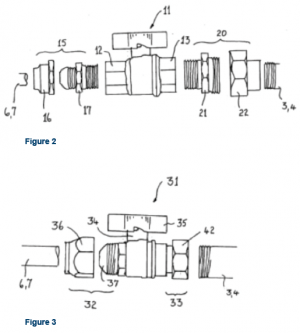Stopping copycats – protecting innovation from imitation – 20 February 2012
Innovation in Australian manufacturing is often left open to copying when it shouldn’t be.
Australian manufacturers and their engineers can be too modest. All too often they consider their new products and/or processes to be simple or “nothing special” rather than recognising them as patentable or otherwise protectable.
You don’t need to re-invent the wheel to qualify for a patent. In a recent Court decision an Australian manufacturer, Zetco Pty Ltd, successfully enforced their Australian standard patent against their competitor, Austworld Commodities Pty Ltd. The Court held that the valve of Figure 3 qualified for a standard patent over the assembly of Figure 2. The decision demonstrates:
- that a new combination of well known features can form the basis of commercially valuable patent protection;
- the Court’s approach to determining whether an invention qualifies for patent protection; and
- the practical application of the principles discussed in “Protecting the function of new products and processes” (p 82, September 2011, AMT magazine).
The invention
Zetco’s patent relates to plumbing fittings for connecting instantaneous gas hot water services. Figures 2 and 3 are taken directly from the patent. Figure 3 shows an example of the invention. Figure 2 shows an older plumbing fitting.
The valve of Figure 3 is a pre-fabricated unit including a pipe coupling 32 and a nut and tail fitting 33. Pipe couplings and nut and tail fittings are well known in the context of plumbing.
Installing the valve of Figure 3 requires only two connections (one to a pipe and the other to the hot water service) in contrast to the five connections required to assemble and install the components of Figure 2. This saves on installation time and reduces the risk of a leak.
Qualifying for patent protection
To qualify for a standard patent an “invention” must be new and inventive. These requirements are considered separately.
Austworld unsuccessfully argued that the invention was not new because the patent covered a valve shown in an earlier brochure. The brochure was published in November 2005. The patent was filed 26 February 2006.
The brochure included an exploded view of a valve similar to the valve of Figure 3. The Court found that the invention was a pre-fabricated unit and that it is strictly new because the brochure did not indicate whether the components shown in the exploded view were connected prior to sale.
The Court also found the valve to be sufficiently inventive. The Australian inventiveness threshold requires a non-obvious variation over a) common general knowledge and b) information that the “skilled person” (an experienced plumber in this case) could be reasonably expected to ascertain.
Zetco and Austworld agreed that the components of Figure 2 were common general knowledge.
In essence, the Federal Court concluded that the difference between Figures 2 and 3 is sufficient to qualify for an Australian standard patent. In making this assessment the Federal Court acknowledged earlier comments from the High Court that “an idea of combining [features] may be simple but may still involve an act of insight that means the combination is not obvious”. The High Court is Australia’s most authoritative Court.
Austworld did not argue that the brochure should be considered when assessing inventiveness. Austworld (and their legal team) likely concluded that the brochure would not qualify for a) or b) because it was not circulated widely enough.
It’s a commercial decision
With the benefit of hindsight, Zetco’s invention might seem simple. Nonetheless, their patent has been found valid and gives them a commercially valuable monopoly in the marketplace.
Very often a new product (or process) will qualify for protection even if it seems simple. So the question becomes “Does pursuing protection make commercial sense?” rather than “Is protection possible?” At the very least, registrability should be considered before dismissing the possibility outright. An experienced patent attorney can provide guidance on the potential scope of protection and the associated costs so that you can make an informed commercial decision.
If protection against copying is of interest, it is important to keep the new product (or process) secret and not sell or commercially use it until an application for protection has been filed. Otherwise many of the opportunities to pursue protection are lost.


